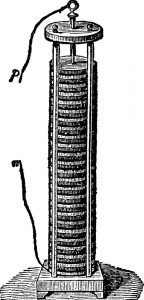All battery models currently manufactured are based on the principle discovered by Alessandro Volta. The scientist invented the so-called Volta Battery, the forerunner of the electric battery. His work was crucial for the history of science since, for the first time, he managed to produce a stable flow of electricity. The pile was made of silver discs and zinc discs separated by cardboard discs soaked in brine.
The Life of Alessandro Volta

Alessandro Giuseppe Antonio Anastasio Volta, the Italian physicist, was born on February 18, 1745, in the Italian city of Como; He received a basic and secondary education of humanistic characteristics, but when he reached higher education, he opted for scientific training. In 1774, he was invited to teach physics at the Royal School of Como. Just a year later, Volta made his first invention: a device related to electricity (the first battery.) With two metallic discs, separated by a wet conductor but joined by an external circuit, he manages, for the first time, to produce direct electric current, he invents the perpetual electrophore, a device that once charged can transfer electricity to other objects.
Between the years 1776 and 1778, he dedicated himself to chemistry, discovered and isolated methane gas. A year later, in 1779, he was appointed full professor of the chair of experimental physics at the University of Pavia.
Animal Muscles
Alessandro Volta was a friend of Luigi Galvani. When Galvani discovered in 1780 that contact with two different metals with the muscle of a frog produced electricity, he also began to do his animal-electricity experiments but came to another conclusion in the year 1794: that it was not necessary the participation of the muscles of the animals to produce electricity.
This finding produced a multiplicity of conflicts, not only with his friend Galvani but with most of the physicists of the time. They were adherents to the idea that electricity was only produced through the contact of two different metals with the musculature of animals. However, when Volta managed to build the first electric battery, he proved that he was right and had won the battle against his colleagues.
The Volta Pile
The volta pile consists of thirty metal discs separated by damp cloths. During the first years of the 19th century, they were built as direct current supply sources. Alessandro Volta communicated his discovery of the pile to the Royal London Society on March 20, 1800. The corresponding letter was read in the audience on June 26 of the same year. After reproductions of the invention made by the members, the society gave Volta the corresponding credit.

In 1801, he traveled to Paris accepting an invitation from Napoleon Bonaparte himself to present the characteristics of his invention at the French National Institute of Sciences. Bonaparte himself enthusiastically participated in the corresponding sessions and exhibitions and recommended Alessandro Volta receive the highest honors for himself. On November 2 of the same year, the commission of scientists distinguished by the National Institute of Sciences to evaluate Volta’s invention issued the corresponding report affirming its validity.
Volta was widely recognized throughout Europe. In 1806 he became a Knight of the Royal Italian Order of the Iron Crown. In 1809, the senator of the Kingdom of Italy, and 1810, count of the Kingdom of Italy.
After the fall of the Napoleonic regime and the consequent Austrian restoration, the Imperial Government of Vienna in 1815 appointed him director of the Faculty of Philosophy at the University of Padua. In 1819 Alessandro Volta left public life and retired to his hometown. After a short illness, he died on about March 5, 1827, at the age of 82.
Curiosities

In 1801, the physicist made a demonstration of his discovery before Napoleon. The emperor recognized his contribution to science by granting him the title of count, naming him Senator of Lombardy, and awarding him the Gold Medal for Scientific Merit. In 1815, after the fall of the Napoleonic regime, the Imperial Government of Vienna appointed him as director of the Faculty of Philosophy at the University of Padua. He was also invited to join the prestigious Royal Society of London. In his honor, the measurements used for this in electrical potential are called a volt, and a crater on the Moon bears his surname.
The Significance of Volta’s Invention
To this day, the voltaic battery is the basis of a large number of electronic devices. All those that have a battery inside are based on the model and experiments carried out by Alessandro Volta during the 18th and 19th centuries. These are just some examples:
- Car batteries: Whether they have an electric motor or not, they all have a battery inside that allows the various electronic systems of a car to function.
- Laptops. They all have batteries that allow us to work or have fun wherever we are without resorting to a fixed electrical outlet.
- Remote controls. The batteries in these devices are a clear example. They closely resemble the initial Alessandro Volta model.
- Smartphones. They all have a battery. And that battery is essential for its autonomy and freedom. These are based on the Volta model.
In addition to its importance in the creation of products, the invention of the first voltaic battery allowed us to delve into the study of electricity, which at that time was still a relatively unknown world and with much potential ahead. It is for this and for all the aforementioned why Alessandro Volta is, undoubtedly, one of the pillars of current electrical energy.
